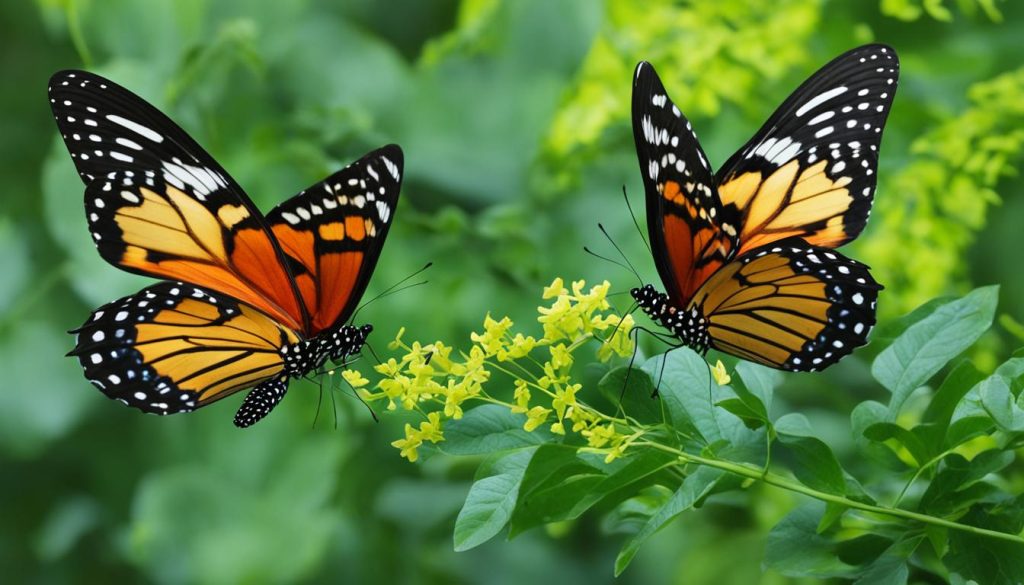The life cycle of a butterfly is a magical and captivating journey that showcases the wonders of the natural world. From the moment a butterfly emerges as a delicate creature from its chrysalis, its sole purpose becomes finding a mate and reproducing. This article delves into the intriguing realm of butterfly mating behavior, courtship rituals, and the intricate reproduction cycle, unveiling the secrets of their captivating dance through life.
Key Takeaways:
- Butterflies undergo a remarkable life cycle that includes the stages of egg, caterpillar, pupa, and adult.
- Mating is essential for the survival and continuation of the butterfly species.
- Butterflies engage in various courtship rituals and visual displays to attract a suitable mate.
- Chemical signals and pheromones play a crucial role in butterfly attraction and mate selection.
- Butterflies form symbiotic relationships with flowers as they seek nectar and aid in pollination.
Butterfly Mating Habits and Reproductive Strategies

In the adult stage of a butterfly’s life, their primary focus is finding a mate and ensuring the continuity of their species. Butterflies employ various mating behaviors and courtship rituals to attract a suitable partner. Visual displays, such as fluttering and circling, are common ways in which butterflies exhibit their attractiveness and agility during courtship.
Additionally, butterflies release chemical signals or pheromones to communicate their availability and receptiveness to potential mates. These chemical messages can play a crucial role in attracting and coordinating the mating activities of butterflies.
Once a compatible mate is identified, butterflies engage in the act of mating, where the male butterfly transfers sperm to the female. This reproductive strategy ensures the fertilization of the female’s eggs, marking the beginning of a new generation. The female butterfly then searches for another host plant on which to lay her eggs, continuing the life cycle of butterflies.
Butterflies also form symbiotic relationships with flowers in their quest for nectar, a vital energy source. As they feed on nectar, butterflies often inadvertently aid in the pollination process, facilitating plant reproduction. This relationship between butterflies and flowers highlights the intricate interconnectedness of nature and showcases the significance of butterfly symbiotic relationships.
| Butterfly Mating Season | Butterfly Attraction and Courtship | Butterfly Reproductive Strategies | Butterfly Symbiotic Relationships |
|---|---|---|---|
| The butterfly mating season varies depending on the species and geographical location. | Butterflies use visual displays, chemical signals, and courtship rituals to attract potential mates. | Butterflies engage in mating behavior and employ various reproductive strategies to ensure successful fertilization and the continuation of their species. | Butterflies form symbiotic relationships with flowers as they seek nectar, inadvertently aiding in the pollination process. |
The Impact of Temperature on Butterfly Behavior
Temperature plays a crucial role in the behavior and functioning of butterflies. The internal temperature of a butterfly’s body needs to be around 82 degrees Fahrenheit for optimal functioning. When the temperature drops, butterflies experience challenges that affect their ability to fly, find food, and escape predators.
To regulate their body heat, butterflies rely on their surroundings. They have clever ways to warm up on cool days. They bask in the sun, using their wings as reflectors to absorb and retain heat. Additionally, butterflies rest on warm surfaces like rocks to absorb warmth into their bodies. They also perform small wing movements, which helps warm their flight muscles.
In contrast, when temperatures are too high, butterflies may face a different set of issues. Excessive heat can damage their fragile wings, causing deformities that hinder their ability to fly properly. This can also impact their feeding habits and overall survival.
Understanding butterfly thermoregulation is vital for their survival and conservation efforts. By studying their behavior in different temperature conditions, researchers can gain insights into how butterflies adapt and respond to their environments. This knowledge can contribute to developing effective conservation strategies to protect these unique and delicate creatures.
FAQ
What is the life cycle of a butterfly?
The life cycle of a butterfly involves several stages, starting with the female butterfly laying eggs on host plants. The eggs hatch into caterpillars, which feed and grow rapidly. The caterpillar then enters the pupal stage, forming a chrysalis. Inside the chrysalis, the caterpillar transforms into a butterfly. Once fully developed, the butterfly emerges from the chrysalis and begins its adult stage.
What behaviors do butterflies engage in to attract a mate?
Butterflies use various mating behaviors and courtship rituals to attract a partner. This can include visual displays like fluttering and circling, as well as the release of chemical signals or pheromones.
How do butterflies reproduce?
Once a suitable mate is identified, butterflies engage in mating. During this process, the male transfers sperm to the female. The female then lays her eggs on host plants, starting the next generation of butterflies.
How do butterflies form symbiotic relationships?
Butterflies form symbiotic relationships with flowers. As they seek nectar for energy, they also inadvertently aid in the pollination process.
How does temperature affect butterfly behavior?
Temperature plays a crucial role in butterfly behavior. Butterflies require an internal temperature of around 82 degrees Fahrenheit for optimal functioning. Cool temperatures, strong winds, and rain can impact their ability to fly, find food, and escape predators. Butterflies regulate their body heat by basking in the sun, using their wings as reflectors, or resting on warm surfaces. They also perform small wing movements to warm their muscles.






